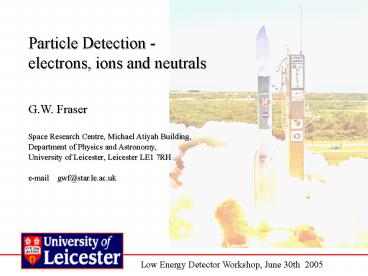Particle Detection - PowerPoint PPT Presentation
1 / 22
Title: Particle Detection
1
Particle Detection - electrons, ions and
neutrals G.W. Fraser Space Research Centre,
Michael Atiyah Building, Department of Physics
and Astronomy, University of Leicester,
Leicester LE1 7RH e-mail gwf_at_star.le.ac.uk
2
- Particle Detection in the SR Domain
- Experimental Modalities
- Photoelectron spectroscopy (PES) including ARPES
- Time-of-flight (TOF) - including high mass
biomolecules? - Threshold photoionisation (TPI)
- PEEM
- XPEEM
- NIXSW, LEED..
- Ion imaging..
- Experimental Requirements
- High time resolution (ps)
- 10eV 10 keV energy range
- Unlimited count rate capacity
- High resolution imaging over large area
- (Electron Spin)
High pressure operation Zero energy detection
3
Why not a Commercial Detector ? SPECS delay
line (left) and SPECTALEED (right)
4
Why not Silicon ? IRD AXUV p-n photodiodes with
very thin (30-70 nm) dead layers
5
Fundamental limits to low-energy ion detection -
window, recombination and Coulombic
interactions (HO Funsten et al., Applied Physics
Letters 84 (2004) 3552).
6
Funding
Michael Atiyah Building
INDUSTRIAL COLLABORATORS Photonis SAS e2v
Ltd. Oxford Instruments CMR EADS Astrium
Photek Pfizer Perpetuity Ltd (UL) Honeywell
Inc. PEKTRON. SIRA AMPTEK Metorex Gresham
Scientific Instruments Lablogic Severn
Science JRA Technology Silson Bayer El
Mul Nova Scientific Inc GlaxoSmithKline Hamamatsu
NON-SPACE RESEARCH PROGRAMMES Bioimaging,
Imaging XRF, SR Detectors and optics, neutron
imaging .
7
Future Missions Mission Instrument
Partners JWST MIRI ESA/NASA/Denmark Astrosat
SXT ISRO Kuafu Auroral Imager China,
Canada Lobster All sky monitor ESA/Russia J-PEX
EUV Spectrometer NRL/NASA ChengE
II Various China BepiColomboMIXS-SIXS ESA/Finla
nd EXOMARS Various ESA Juno Auroral imager
NASA WSO UV Spectrometer Russia XEUS Various
ESA,SRON
8
Another novel use for MCPs dust detection on the
ISS
Microchannel Plates bearing 60nm thick Al film
thermal barriers were exposed on the Russian PIRS
module to the external ISS environment for 734
days
- The films are a factor of 10 more sensitive
than previous foils - The impacts reveal the presence of a high density
of previously unobservable nanoscale particles
either debris or natural dust
9
Current Research In Microchannel Plate
Detectors 1. Basic physics of the particle
interaction 2. Small pore MCPs - 2, 3, 4.5 and 6
micron pores the EUV QE problem and higher time
resolution 3. High count rate operation - gold
electrodes, heat sinking and Bulk Conductivity
Glass (funded by CCLRC Instrumentation
Department) 4. Novel readout - aSi panels, radial
CODACON for TEARES
10
Basic physics of the particle interaction The
ion detection efficiency of MCPs, G.W.Fraser,
Int.J.Mass.Spect 215 (2002) 33-50 Microchannel
plate resistance at cryogenic temperatures
P.Roth and G.W. Fraser, Nucl.Instr.Meth A
439 (2000) 134-7. The gain, temporal resolution
and magnetic field immunity of microchannel
plates, G.W.Fraser, Nucl.Instr.Meth A 291 (1990)
596-606.
11
Ion Detection efficiency comparison with Gao et
al. (1984), 1 keV protons influence of
end-spoiling h/D and critical angle
12
Calculated variation of high mass ion detection
efficiency as a function of ion energy
13
Small Pore MCPs for high time resolution
6 micron 95 ps,133 ps
3 micron pore 66 ps,110 ps
Ratio of rise times expected 1.44 measured
1.53 Burle 2 micron pore MCPs available
Courtesy Jon Lapington/ Photek/ Photonis
14
TEARES
15
The Radial CODACON
16
(No Transcript)
17
(No Transcript)
18
TEARES CODACON electronics chain
1 of 12 parallel channels
Microchannel plates
Codacon anode
Logic in FPGA
Computer interface
Charge sensitive pre-amp
Pulse shaper
Bit decision
Threshold comparators
Histogram memory
Summer
Other channels
HV supplies
Threshold
Reference voltage from analyser
19
MCP Count Rate Limitations Resistance-versus-time,
voltage for large format 6 micron plates
20
BULK CONDUCTIVE GLASS
WP3 UP DATE 19th MAY 2005 TRIALS MADE SINCE THE
MEETING OF DECEMBER A)Trials at the collapsing
stage gt standard capsule without vacuum and
not connected at the equipment at 575, 580, 590,
600, 605C to evaluate the stability of the glass
and the compatibility with the core glass gt
595C has been selected B) First draw at 595C
(maxi T) with a little assembly
Problem, Need to decrease of 5C the draw
temperature
21
BULK CONDUCTIVE GLASS
WP3 UP DATE 19 MAY 2005 TRIALS MADE SINCE THE
MEETING OF DECEMBER C) Machining the 400 mm
cladding glass at 38,5 (like M)
gt Big problems, 2 cylinders are broken (bad
annealing ??) during the machining
gt Glass is very hard (lapping is 10 times
longer than for 297 ) And big problems have been
encoutered. 2 short rods (200 mm have broken) and
one long rod might be broken D) Decision has
been taken to etch the glass instead of machining
it gt Different trials have
been made to select HNO3, 65 at 60C during 5
hours.Next trials must be made on 500 mm
cylinders week 22.2005
22
(No Transcript)































